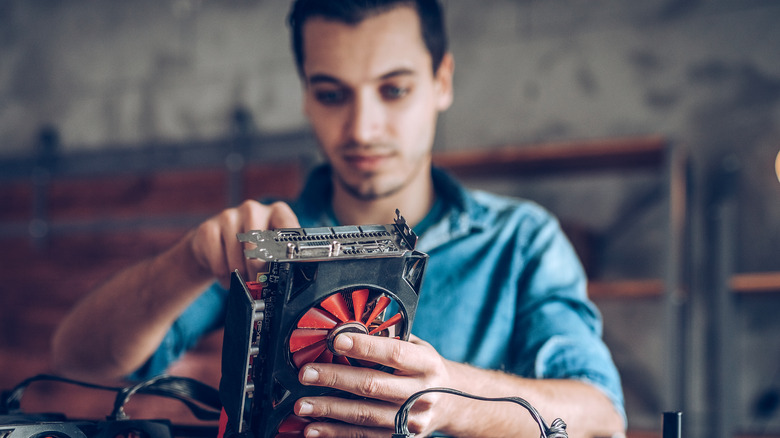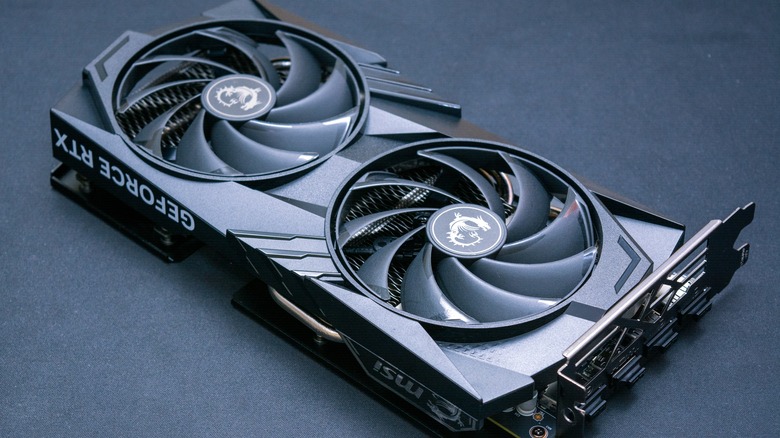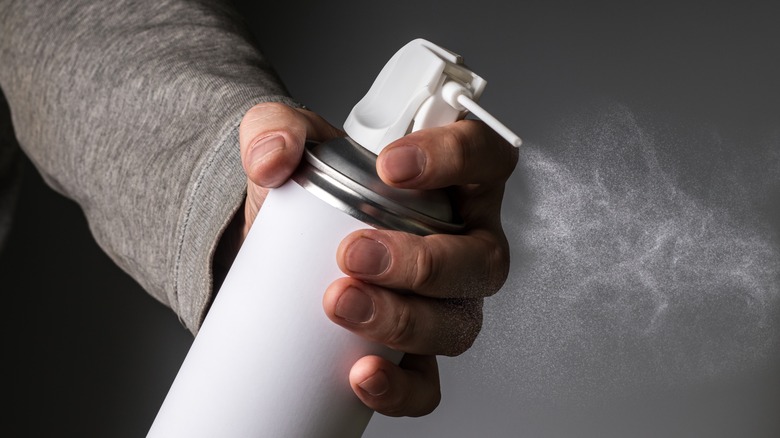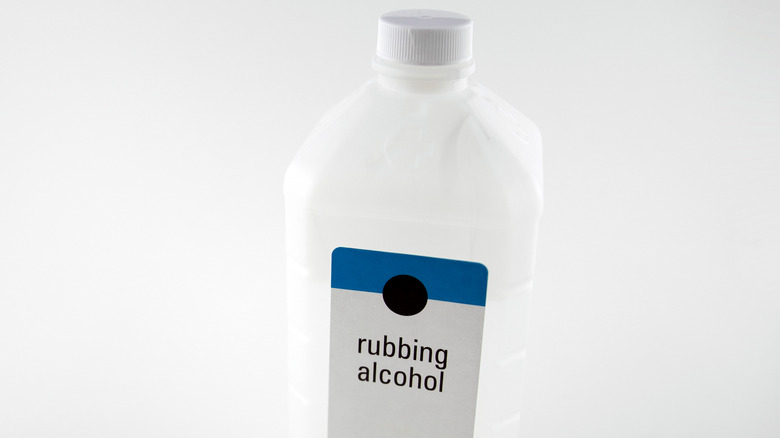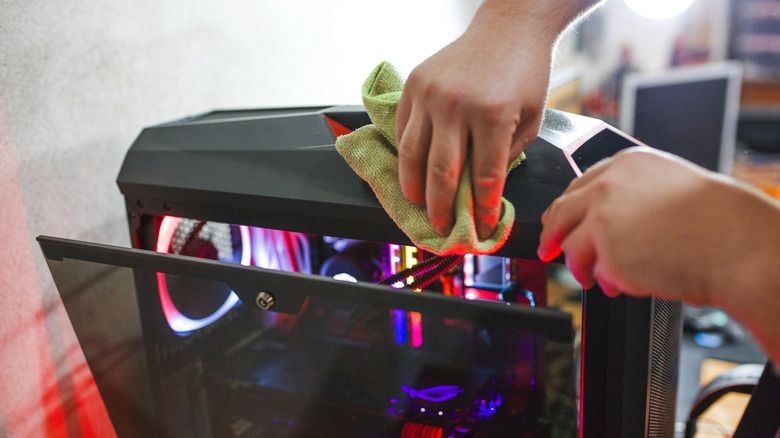The Right Way To Clean Your PC's Graphics Card (And Why You Should)
We may receive a commission on purchases made from links.
The graphics processing unit, AKA the GPU, is one of the most important components in your PC. While the CPU is often referred to as the brain of the computer since it handles most of the processing that has to do with actual computing tasks, the GPU is the workhorse that takes all that information and uses it to generate the images you see on your monitor. This essentially means that your graphics card is solely responsible for one of the most complex and power-consuming tasks that your computer performs. It does this best under conditions where it can work at peak efficiency, and it functions a whole heck of a lot better when it's clean.
People who only ever use their computer to surf the internet and occasionally watch YouTube or Netflix might not need to get much performance out of their GPU. But gamers, graphic designers, animators, video editors, and anyone else performing highly demanding, visual-oriented computing tasks will usually want to squeeze every last frame they can get out of it. Dirt and dust might not seem like a big deal, but they can severely inhibit your graphics card's ability to do its job. That means cleaning it is very important.
Why clean out your GPU?
So what is it about dirt and dust that seems to cause so many issues in a graphics card? Well, to understand that, you first have to understand that GPUs take up an awful lot of power. Different models have different power consumption requirements, but high-end gaming GPUs from major brands can take up more than half of a PC's power allotment on their own. Nvidia's 4090, for instance, requires a whopping 450W of electricity to operate.
The next thing you need to understand is that nearly all of that energy gets converted into heat. Ever put your hand on the back of your computer and feel how much hot air is being pushed out? Well, about half of that is being generated by your graphics card. GPU manufacturers have gotten very good at finding methods for channeling this heat away from your graphics card so that it can dissipate into the air. Still, dust and debris can actually insulate the card, keeping the heat trapped inside. Even the finstacks that are designed to help dissipate this heat don't work as well when they are coated in dust.
Most modern graphics cards have a safety feature built in so that they can throttle their own energy intake before they get hot enough to be damaged. An unfortunate side effect of this feature is that they no longer work as well as they did when they were running at full power. Cleaning out your GPU can allow it to go back to working like normal.
Compressed air
There are a couple of methods for cleaning out your graphics card, but by far, the least invasive is to simply blast the dust out of it using compressed air. To do this, you will either need a disposable can of compressed air or a low-volume air compressor. Many of these are designed specifically for cleaning computers and can be found on Amazon for around $30-$50. Be careful never to turn the disposable cans upside down while using them as they may release many of the chemicals resting in the bottom of the can, which can damage your computer.
Before cleaning out your GPU, you should first shut down your PC and then turn off the voltage switch on your power supply. After that, open up your PC and remove the GPU. There should be a small release lever on the side of the PCIe port where it is plugged in. You may also have to remove a couple of thumbscrews attaching the GPU to the PC's rear IO port.
Next, take it outside to avoid shooting dust all over the inside of your house. Use the compressed air to carefully blast away any dirt, dust, hair, and lint that may have settled inside your GPU. Aim for the vents in the side, and be sure to thoroughly blast the finstacks on the bottom of the GPU that is used to dissipate heat. This should only take a couple of minutes.
Alcohol and a coffee filter
Cleaning your GPU out with air is the least invasive method, but it only works on dry debris resting on and inside the card. Humidity that has made its way inside your computer can sometimes cause the dust to get caked onto the components, and no amount of propelled air is enough to knock it loose. The only way to clean that is to gently remove it with high-concentration isopropyl rubbing alcohol.
To clean the outside of the card, remove it from the PC just like before. You will need to clean it using rubbing alcohol that is at least 90% concentrated on a lint-free cloth. Many people suggest coffee filters, as they don't produce static or lint. Cotton swabs aren't as good, but can be useful for getting to hard-to-reach places. Clean off all the dust you can see while being careful not to damage any pins or wires. Then, allow the alcohol to evaporate before reinserting your card.
Cracking your GPU open and cleaning it out from the inside may require special tools (such as screwdrivers designed for electronics repair like those sold by iFixit) and will probably void your graphics card's warranty. This should only be attempted by those who are confident in their technical skill and whose warranty is already void. Anyone else should contact the manufacturer's warranty department or a computer repair company to clean the inside of the card.
Keeping your PC clean
Once all that is done, your graphics card should be completely clean and hopefully back to performing like normal, but there are a few steps that you can take to make sure that it won't get dirty again too quickly.
The first is to safely clean out the rest of your computer. There's no point in placing your sparkly, clean GPU back in a filthy case after all. You'd just have to clean it again in no time. Take the tower outside and blast out the whole thing with compressed air. Take special care to remove any mesh filters that are placed in front of your fans and thoroughly clean them out as well. This will help to prevent more dust from getting in the case and allow better airflow to your components.
The second is to place your PC in a good, clean space somewhere that is not on the ground. Most of the dust, dirt, pet hair, and other debris in your house settles to the floor and can easily be picked up by your PC's cooling fans. Keeping it off the ground will dramatically extend how long you can go between cleanings. Consider placing the tower on a box or a shelf if there isn't space on your desk.
